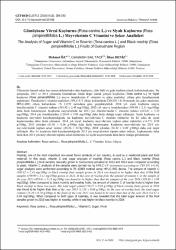Gümüşhane Yöresi Kuşburnu (Rosa canina L.) ve Siyah Kuşburnu (Rosa pimpinellifolia L.) Meyvelerinin C Vitamini ve Şeker Analizleri
Erişim
Attribution 3.0 United Statesinfo:eu-repo/semantics/openAccesshttp://creativecommons.org/licenses/by/3.0/us/Tarih
2018Erişim
Attribution 3.0 United Statesinfo:eu-repo/semantics/openAccesshttp://creativecommons.org/licenses/by/3.0/us/Üst veri
Tüm öğe kaydını gösterÖzet
Ülkemizin önemli odun dışı orman ürünlerinden olan kuşburnu, tıbbı bitki ve gıda maddesi olarak kullanılmaktadır. Bu çalışmada, 2013 ve 2014 yıllarında Gümüşhane ilinde doğal olarak yetişen Kuşburnu (Rosa canina L.) ve Siyah kuşburnu (Rosa pimpinellifolia L.) meyve örneklerinin C vitamini ve şeker analizleri yıllara göre karşılaştırarak yapılmıştır. Örneklerin C vitamini analizleri, HPLC-UV cihazı kullanılarak ?SN EN 14130 metodu ile; şeker analizleri, HPLC-RID cihazı kullanılarak TS 13359 metoduna göre gerçekleştirildi. 2014 yılı siyah kuşburnu meyve örneklerindeki C vitamini miktarı (305.92 ± 2.45 mg/100g), 2013 yılı meyve örneklerinden (199.90 ± 2.11 mg/100g) daha fazla bulunmuştur. Kuşburnu meyvelerinde ise 2013 yılı örneklerindeki C vitamini miktarı (423.61 ± 5.13 mg/100g), 2014 yılı örneklerinden (320.43 ± 3.98 mg/100g) daha fazla olduğu tespit edilmiştir. Siyah kuşburnu ve kuşburnu meyveleri karşılaştırıldığında ise kuşburnu meyvelerinin C vitamini miktarları bu iki yılda da siyah kuşburnundan daha fazla olmuştur. 2014 yılı siyah kuşburnu meyvelerinin toplam şeker miktarları (16.57± 0.58 g/100g), 2013 yılından (11.01 ± 0.66 g/100g) daha fazla bulunmuştur. Kuşburnu meyvelerinde ise 2013 yılı meyvelerindeki toplam şeker miktarı (18.26 ± 0.74g/100g), 2014 yılından (16.32 ± 0.49 g/100g) daha çok tespit edilmiştir. Her iki kuşburnu türü karşılaştırıldığında 2013 yılı meyvelerinin toplam şeker miktarı, kuşburnunda daha fazla iken 2014 yılı meyvelerinin toplam şeker miktarının ise siyah kuşburnunda daha fazla olduğu görülmüştür. Rosehip, one of the most important non-wood forest products of our country, is used as a medicinal plant and food material. In this study, vitamin C and sugar analyzes of rosehip (Rosa canina L.) and black rosehip (Rosa pimpinellifolia L.) fruit samples naturally grown in Gumushane province in 2013 and 2014 were compared according to years. Vitamin C analyzes of the samples were carried out by HPLC-UV instrument according to ?SN EN 14130; sugar analyzes were performed according to TS 13359 method using HPLC-RID device. The amount of vitamin C (305.92 ± 2.45 mg/100g) in black rosehip fruit sample grown in 2014 was found to be higher than that of the fruit samples (199.90 ± 2.11 mg/100g) grown in 2013. In the case of rosehip fruit, the amount of vitamin C in the sample of the year 2013 (423.61 ± 5.13 mg/100g) was found to be higher than that the samples of the year 2014 (320.43 ± 3.98 mg/100g). When compared to black rosehip and rosehip fruits, the amount of vitamin C of rosehip fruits is higher than black rosehip in these two years. The total sugar content (16.57 ± 0.58 g/100g) of black rosehip fruits grown in 2014 was found to be higher than that of the year 2013 (11.01 ± 0.66 g/100g). In the case of rosehip fruit, the total sugar content (18.26 ± 0.74 g/100g) in the fruits of the year 2013 was found to be more than that of the year 2014 (16.32 ± 0.49 mg/100g). When compared to both types of rosehips, it was revealed that the total sugar amount of the fruit samples grown in 2013 was higher in rosehip, while it was higher in black rosehip in 2014.
Cilt
8Sayı
2Bağlantı
https://doi.org/10.17714/gumusfenbil.327635https://app.trdizin.gov.tr/makale/TWpreE1qazVPUT09
Koleksiyonlar
Aşağıdaki lisans dosyası bu öğe ile ilişkilidir:



















